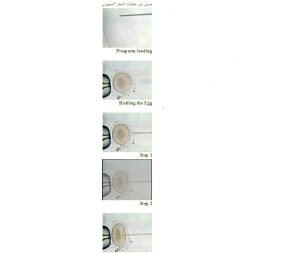Microscopy
Is the process of inserting the sperm directly into the cytoplasm of the egg is an effective method, and uses only one sperm and not as in the process of the children of the tubes that put tens of thousands of sperm next to the egg and are thus injected egg after the removal of cells adjacent to the egg and these The method is ideal and currently preferred and this method is considered an evolution because in this way it is possible to vaccination even with the use of very few sperm.
This process involves the use of special instruments and an inverted microscope so that the laboratory technician can withdraw the sperm using a special injection needle, which is inserted carefully through the membrane of the egg and then injected sperm into the inner part of the egg (cytoplasm), then fertilization occurs in 75 – 85% of sperm fertilized with sperm.
The reasons for resorting to micro-injections:
- Male infertility factors, including poor sperm count, poor sperm movement, poor semen quality, sperm inability to pass through the egg membrane, lack of semen sperm.
- Fertility has not occurred in previous pipe attempts.
- If the husband undergoes vasectomy and if sperm are collected from the testicle or epididymis.
- If the husband has problems with erection or ejaculation.
- This method is suggested for couples in the case of production of a few oocytes to increase the proportion of fertilized eggs compared to the process of the children of ordinary tubes.
- In some clinics, this procedure is used only in cases of severe male infertility. On the other hand, this method is used by some clinics in all cases.
Method of action of micro-injections:
- The ovulation of the wife is stimulated to produce the largest number of eggs.
- The oocytes are then assembled using a fine needle under the ultrasound guidance.
- The sperm is pulled by a thin needle carefully inserted through the wall of the egg into the egg’s cytoplasm. The sperm is then injected and the needle is removed. This step does not confirm the occurrence of fertilization, but it gives an opportunity for fertilization to start and produce embryos.
- The embryos are then returned to the uterus two to three days after fertilization or the fifth day after fertilization when the embryos reach the stage of blastocyst.
- Pregnancy screening is done two weeks after the fetus is returned.
Images of Microscopy
Presperm loading
Holding the Egg

Methods of obtaining sperm that are used in micro-injections:
- If sperm cells are present in semen, the sperm sample is produced by normal ejaculation in a special container on the same day as the oocytes are withdrawn.
- In the absence of sperm sperm, sperm is obtained from the husband by:
Pull the sperm from the epididymis and inject the microscopy of the egg
The beneficiary of this method is usually who complains of one of the following problems:
* Do not (create) sperm.
* The presence of severe infections such as tuberculosis, which is concentrated in the genital area, or other venereal diseases that block the ducts of sperm that can not be treated surgically.
If the sperm is accidentally cut, for example, when a specific surgery is performed, and attempts to repair it are unsuccessful.
This method is accomplished by the withdrawal of sperm from the beginning of the epidermal contact of the epididymis, the area where the sperm have been newly produced and has the most effective in movement and the ability to fertilize and then the procedure is performed microscopy of the egg as mentioned earlier.
* Extract sperm from the testes and microscopic injection of the egg
These methods are used to extract sperm from the testis directly either by TESE or by TESA and then used for microbial injection as mentioned above and used in the following cases:
– The absence of sperm in the epididymis.
– Blockage of the epididymis or lack thereof.
– Blockage or lack of semen channels.
Disadvantages of Microscopy:
Multiple pregnancy and ectopic pregnancy.
- The incidence of congenital malformations such as cerebral palsy increases from 3% in normal pregnancy to 6% in pregnancy resulting from IV and IV.
- Increase the rate of genetic defect that is delivered to the child from the sperm because the process of injecting the microscopic beyond the stage of natural selection of the sperm, which is the normal pregnancy through which the selection of the sperm is stronger for vaccination.
- Microscopy cost is higher than pipe children.

